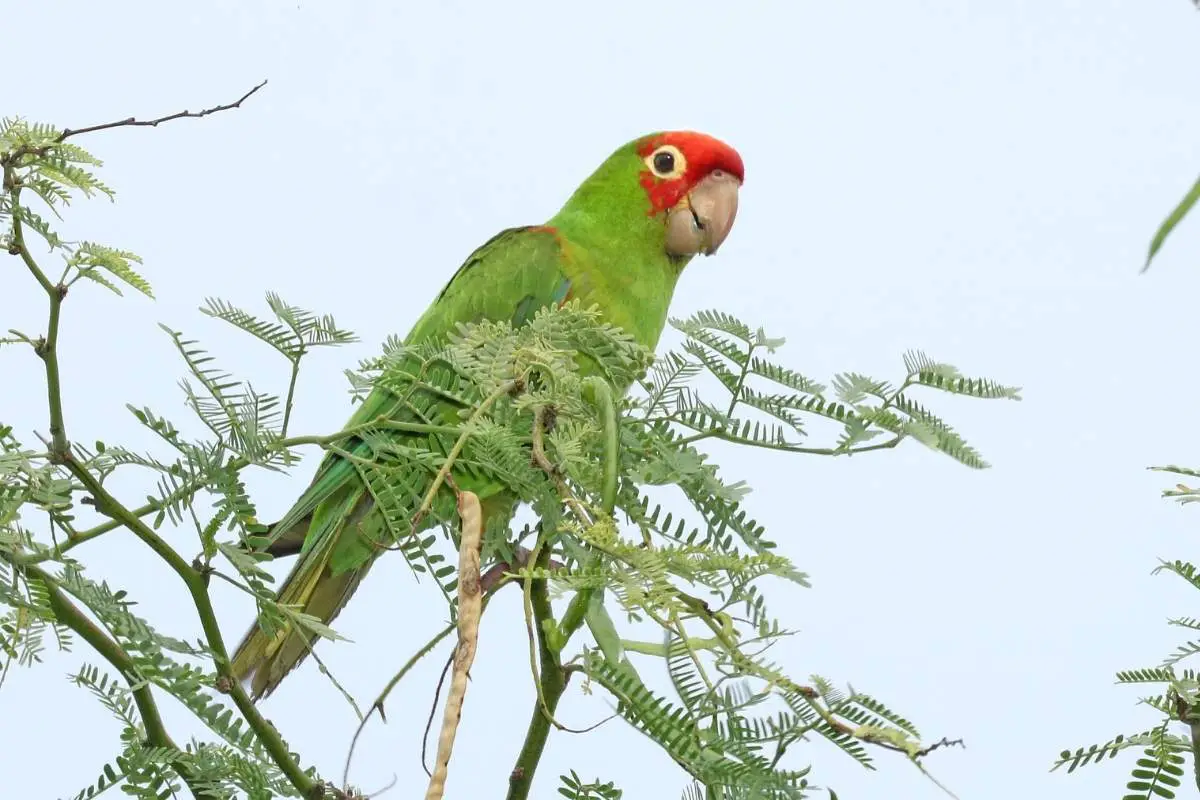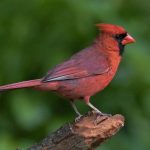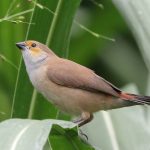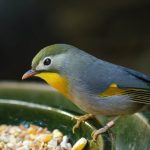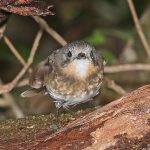Common Name: Red-masked Parakeet
Scientific Name: Psittacara erythrogenys| Size | Diet | Range in Hawaii | Status in Hawaii |
|---|---|---|---|
| 13 in. | seeds, nuts, fruit, and vegetables | Big Islands | near threatened |
The Red-masked Parakeet, also known as the Red-masked Conure or the Cherry-headed Conure, is a small, colorful parrot native to Ecuador and Peru in South America. It is a popular pet due to its playful and energetic personality, as well as its bright red and green plumage.
The Red-masked Parakeet is known for its high intelligence and ability to mimic human speech, making it an entertaining and engaging companion. These parakeets are social birds and thrive in a flock setting, so it is important to provide them with plenty of stimulation and interaction.
Red-masked Parakeet
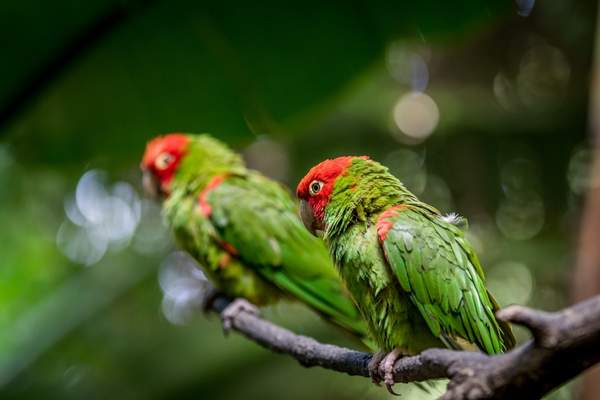
Appearance
The Red-masked Parakeet is a small to medium-sized parrot, typically measuring around 13 inches in length and weighing around 4-5 ounces. It has a distinctive appearance with a bright red head and mask, green body, and a pale blue chest.
The wings and tail are green with blue edges, and the beak is a dark gray or black color. These parakeets are sexually dimorphic, meaning males and females can be distinguished by their appearance.
The male has a more vibrant red head and mask, while the female has a less intense red head and mask with a brownish tinge. The Red-masked Parakeet has a compact and stocky build with a round head and short, square tail. Its wings are relatively short, allowing it to fly well in confined spaces but not for long distances.
Diet
The Red-masked Parakeet, like all parrots, requires a varied and balanced diet to maintain good health and prevent nutrient deficiencies. In the wild, these parakeets primarily feed on seeds, nuts, fruit, and vegetables. In captivity, a diet consisting of a variety of seeds, pellets, vegetables, and fruits can provide the necessary nutrients for these birds.
These parakeets also require access to a source of calcium, such as cuttlebone or mineral block, to maintain healthy bones. It is important to avoid feeding the Red-masked Parakeet avocados, chocolate, caffeine, alcohol, and any foods that are high in salt or sugar, as these can be toxic to parrots.
Behavior
The Red-masked Parakeet is a playful and energetic parrot with a lively and sociable personality. These parakeets are intelligent and are known for their ability to mimic human speech and sounds. They are active birds that require plenty of mental and physical stimulation, and they enjoy playing with toys, climbing, and exploring their environment.
Red-masked Parakeets are social birds and do best when kept in a flock setting, either with other parakeets or with human companions. They are known for their affectionate nature and can form strong bonds with their owners.
Nesting
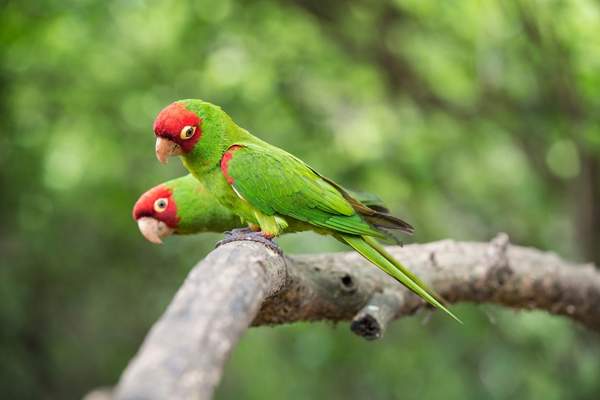
The Red-masked Parakeet is a cavity-nesting species, which means that it will typically nest in a hole or crevice in a tree or other natural cavity. In captivity, these parakeets can be provided with a nest box to lay their eggs in. The nest box should be spacious enough for the parakeets to move around and turn around in, and should have a smooth, non-porous floor to prevent the eggs from rolling around.
The nest box should also have a secure lid to keep the eggs and chicks safe and to prevent the adults from escaping. When preparing to lay eggs, the female Red-masked Parakeet will often become more attentive and affectionate towards her mate, and may also become more possessive of the nest box.
The female will lay her eggs in the nest box, usually one or two eggs at a time, with an incubation period of around 23-24 days. Both the male and female will take turns incubating the eggs and feeding the chicks when they hatch. The chicks will fledge, or leave the nest, around 8-12 weeks after hatching.
Habitat
The red-masked parakeet is found in humid, lowland forests, especially along rivers and streams. It is also found in areas with tall trees and dense undergrowth, where it can find food and shelter.
Range
According to the Hawaii Birding Trails website, the red-masked parakeet is a released cage bird that was first observed on the Big Island in 1988. These birds forage along the Kona coast but roost and breed in pit craters at high elevations on Hualālai mountain.
Conservation Status
According to the IUCN Red List, the Red-masked Parakeet is classified as “near threatened,” which means that it is not currently endangered, but it is at risk of becoming endangered in the near future due to various threats such as habitat loss and trade. The IUCN notes that the population of the Red-masked Parakeet has declined in recent years and that it is likely to continue declining in the future.
Interesting Facts
1. They are popular as pets
Red-masked Parakeets are popular as pets due to their charming personalities and ability to mimic human speech.
2. They are highly social
These parakeets are highly social and often found in large flocks in their natural habitat. They are also known for their loud calls and playful behavior.
3. They are known for their striking appearance
Red-masked Parakeets are known for their striking appearance, which includes a bright red head and breast, green wings and body, and a blue tail.
4. They are intelligent
Red-masked Parakeets are known for their intelligence and problem-solving abilities. They are also skilled climbers and enjoy chewing and foraging for food.
5. They are omnivorous
These parakeets are omnivorous, feeding on a variety of seeds, fruits, nuts, and insects in the wild. In captivity, they can be fed a diet of commercial parrot seed mixes, fresh fruits and vegetables, and occasional treats such as cooked beans or grains.
Frequently Asked Questions
How do I care for a Red-masked Parakeet as a pet?
To care for a Red-masked Parakeet, it is important to provide a spacious, well-ventilated cage or aviary with plenty of toys and perches for mental and physical stimulation.
Are Red-masked Parakeets good pets for children?
Red-masked Parakeets can make good pets for children, provided that the child is old enough to handle the bird safely and responsibly and is supervised by an adult. These parakeets are intelligent and can be trained to do tricks and mimic human speech, which can be entertaining for children.
How do I train a Red-masked Parakeet to talk?
To train your parakeet to talk, try repeating simple words and phrases in a clear, consistent tone. Encourage your parakeet to mimic your words by offering treats or praise when they repeat a word correctly. It is also helpful to expose your parakeet to a variety of sounds and languages to help them develop their vocal skills.
